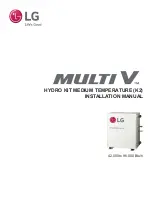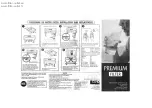
PWF Filter Systems
5
Safety Information
This water conditioner’s control valve conforms to UL/CE Standards.
Generic valves were tested and certified for compliance as verified by
the agency listing.
• Please review the entire Installation and Operation Manual
before installing the water conditioning system.
• As with all plumbing projects, it is recommended that a
trained professional water treatment dealer install the water
conditioning system. Please follow all local plumbing codes for
installing this water conditioning system.
• This system will not make microbiologically unsafe water safe.
Water that is unsafe must be treated separately from this
conditioner.
• This water conditioning system is to be used only for potable
water.
• Inspect the water conditioning system for carrier shortage or
shipping damage before beginning installation.
• Use only lead-free solder and flux, as required by federal and
state codes, when installing soldered copper plumbing.
• Use caution when installing soldered metal piping near the
water conditioning system. Heat can adversely affect the plastic
control valve and bypass valve.
• All plastic connections should be hand tightened. Teflon® tape
may be used on connections that do not use an O-ring seal.
Do not use pipe dope type sealants on the valve body.
Do not
use pliers or pipe wrenches.
• Use only the power transformer supplied with this water
conditioning system.
• All electrical connections must be completed according to local
codes.
• The power outlet must be grounded.
• Install an appropriate grounding strap across the inlet and
outlet piping of the water conditioning system to ensure that a
proper ground is maintained.
• To disconnect power, unplug the AC adapter from its power
source.
• Observe drain line requirements.
• Operating water temperature: 40° to 110°F (4° to 43°C).
• Keep the media tank in the upright position. Do not turn upside
down or drop. Turning the tank upside down or laying the tank
on its side can cause media to enter the valve.
• Use only regenerants designed for water conditioning. Do not
use ice melting salt, block salt or rock salt.
During cold weather it is recommended that the installer warm
the valve to room temperature before operating.
Teflon
®
is a trademark of E.I. duPont de Nemours.
• Do not use petroleum-based lubricants such as Vaseline, oils
or hydrocarbon-based lubricants. Use only 100% silicone
lubricants.
• Do not support the weight of the system on the control valve
fittings, plumbing, or the bypass.
• Do not allow this water conditioning system to freeze. Damage
from freezing will void this water conditioning system’s warranty.
• Observe all warnings and notes that appear in this
manual
Pre-Installation Considerations
(continued)
G. Pre Installation and Loading of Media
Systems that are 13” in diameter and larger are not loaded with
media. These systems must be loaded with media before placing
into service. To load a system follow the below steps.
1. Cap the top open end of the distributor tube with tape and
plastic sheeting to keep foreign debris from entering the
distributor tube. This cap must be secure and not come off
during media loading.
2. Place the distributor tube, screen end down, into the mineral
tank and center it in the bottom. The top of the distributor tube
should be flush with the top of the tank.
3. Make sure the plastic and tape cap is secure to the top of the
distributor tube, place a funnel on the top of the tank and load
first the gravel (if different sizes of gravel are used load the largest
gravel first, then the smaller gravel) then the resin media into the
tank. The cap must not come off of the distributor tube during
the loading of the media.
4. Remove the plastic cap from the distributor tube. DO NOT PULL
UP ON THE DISTRIBUTOR TUBE when removing the cap. The
distributor tube top must remain flush with the top of the tank.
5. Clean any media from the threads and top of the mineral tank.
6. Lubricate the O-rings on the bottom of the control valve
(distributor pilot O-ring and top of tank O-ring). Use non-
petroleum based silicone lubricant only.
7. Place the control valve on top of the tank. When doing this step,
seat the top of the distributor tube inside the centered O-ring
sealed port on the bottom of the valve first then press the valve
down until the tank threads come in contact with the valve
threads. This ensures that the distributor tube is properly seated
into the bottom of the control valve. Thread the valve on to the
tank clockwise. Be careful not to cross thread the valve or over
tighten it. A hand tight snug fit is appropriate for the control valve
torque. A wrench is not necessary. Do not use thread sealant or
PTFE tape on the valve base threads.
8. The system is now ready for installation. Follow the Installation
Section in the Installation, Operation and Maintenance Manual.






































